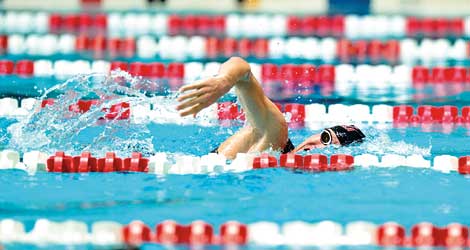Fix Your Stroke: High Elbow Recovery
'Keep your elbows high' is one of the most common utterances by swim coaches.

‘Keep your elbows high’ is one of the most common utterances by swim coaches. Unfortunately the reasons why a swimmer should have a high elbow recovery are perhaps the least well explained.
Understanding why you should keep your elbows high and knowing how to practice it can make you a more efficient swimmer and prevent shoulder injuries.
It is easy for a coach to harp on your recovery because it is the only part of the stroke he or she can clearly see without water obstruction (or water refraction for you physicists). Unfortunately, this is the opposite for you the swimmer; it is the only part of the stroke that you connect see. You might be able to catch a glimpse of your arm recovery as you breathe, but this takes conscious effort.
A high elbow recovery requires only two things:
1. The bony tip of the elbow be pointing towards the ceiling or sky
2. The elbow is creating about a 90 degree angle between the forearm and upper arm
It is very common for swimmers to be doing one of the two, but to achieve the proper technique you need to perfect both.
Realizing a high elbow recovery can make you a more efficient swimmer. A high elbow recovery will reduce unnecessary sideways movement which will diminish energy expenditure in the shoulders and torso. Having a proper recovery will also allow a proper hand entry. A high elbow will allow your hand, wrist and forearm to slide or slip into the water just above your head. If your hand and forearm swing high or wide it can result in a high powered but ineffective ‘slap’ or slice entry. This type of improper recovery can result in your having a cross over (where hand goes beyond midline of body) and can produce a sway in your body.
The second reason to work on a high elbow recovery is to reduce the chance of injury. Combining a good shoulder roll with a high elbow recovery can reduce cantilever-type stress on the shoulder joint.
You can do the following exercise out of the water to really get a feel for this type of joint and muscular stress:
Sit or stand and extend your arms straight out to the side. Hold this position for 1 minute. Then bend your elbows 90 degrees and feel the difference in your shoulders.
This difference in stress on the shoulder is very similar to swimming with and without the proper high elbow bend during the recovery. Considering that most people will turn each arm 1200 to 1800 times in a 3000 meter workout, the cumulative joint stress can be significant.
The best way to correct or perfect your high elbow recovery is by being videotaped and by doing drills. Video taping is the most powerful correction tool. We often see images of ourselves running, biking and strength training, but rarely, if ever, do we get good visual feedback on our swim stroke. There are many coaches and technicians out there who will video tape and analyze your stroke. However, you don’t need to hire a professional; you can just as easily get a friend to tape you and do your own analysis using on-line comparisons with good swimming videos.
Doing drills is the next step to perfection. The best high elbow drills are Finger-Tip-Drag, Tarzan and One-Arm-With-A-Board.
Finger-Tip-Drag: Swim freestyle with a strong kick and a slightly slower arm cadence. During the recovery phase lightly drag your fingers across the surface of the water until your hand reaches shoulder level. At that point, raise your fingers above the surface and glide you hand and forearm into the water on a 45 degree angle. Master the Finger-Tip-Drag before moving on to the Tarzan drill.
Tarzan: Swim freestyle with a strong kick and keep your core engaged. During the recovery phase keep your hand below the surface of the water until your hand reaches shoulder level. At this point, raise your hand above the surface and glide you hand and forearm into the water on a 45 degree angle. This will force you to use your deltoid and it will force your elbow into the proper position during whole recovery phase.
One-Arm-With-A-Board: Using a kickboard, kick with your head out of the water. At the same time, do freestyle stroke with one arm as you hold the board with the other. Observe your arm recovery and make sure that the elbow is at 90 degrees, that the elbow is pointing straight up, that the forearm is relaxed and that your hand is entering just ahead of your head with a 45 degree angle. Other than videotaping this will be your only chance to watch your arm as it recovers over the water.
Correcting and perfecting a high elbow recovery can help reduce inefficient sway and help to set up your hand entry. Having a high elbow recovery can also reduce cantilever stress on your shoulder joint. It is part of the swimming technique that is relatively easy to fix with good visual feedback and diligent drill work. The payoffs are not only better efficiency and lower chance of injury, but having a high elbow recovery may reduce the nagging from your coach as well!
